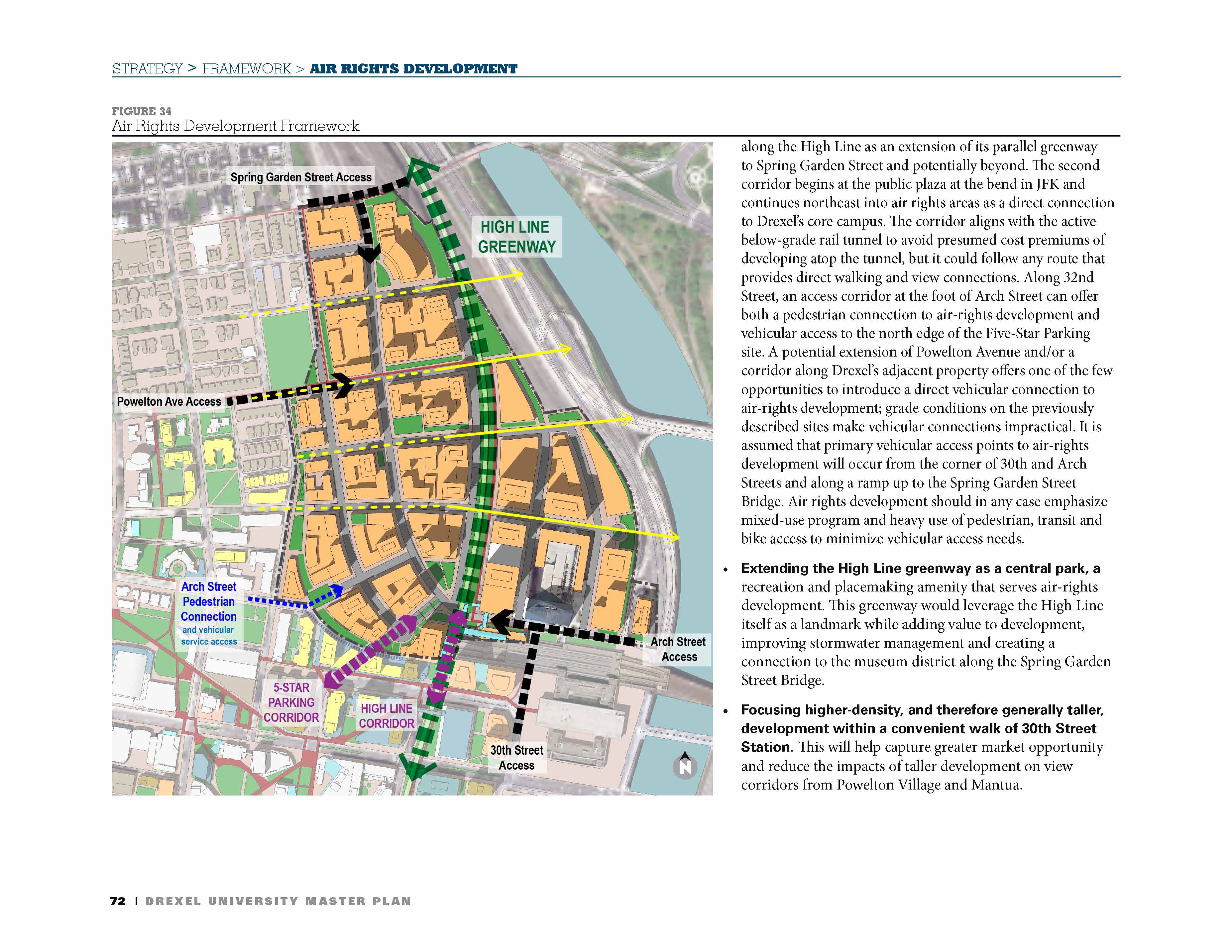Back in September 2012 I wrote a post called
The Space Between, in which I detailed urban design treatments linking the Penn and Drexel campuses together by extending the very successful Drexel platform a block further. I also proposed, more daringly, that the High Line be treated as the spine of a boulevard running from Penn Park up to JFK Boulevard, framing and defining a neighborhood-defining space.
 |
| The Space Between: Red is Drexel, Yellow UPenn, blue commercial, purple residential. Green is greenspace, and those two blue lines show the build-to lines framing 31st St. Boulevard. |
The gist of this post is that: (1) Penn and Drexel ought to cooperate to extend the 32nd St. greenway/cap south to Walnut, (2) Penn needs to redevelop the 3201 Walnut garage, which has some cool features but is horrendous at street level, (3) it also needs to redevelop Rittenhouse Labs' Walnut streetwall, and (4) both have more to gain using the (quite active) High Line to define a 31st Street boulevard than mooning over a park proposal that ain't never gonna happen*.
The Space Between also defines the key infrastructural and public-sector moves needed to fully urbanize the 30th Street area.
However, this area has two wings. Let us focus first on the south wing, defined by Penn Park.
 |
| Around Penn Park. The park is in green; blue is 100 Schuylkill; purple, proposed residential on air rights; yellow, Penn's land bank. In black note the extension of Schuylkill Boulevard atop the Schuylkill Expressway. |
Fairly large chunks of the park, most famously the parking lot along Walnut, but also self-evidently the parking lot and disused greenswards anti-framing South, are land bank. The park was created
in general to (1) sponge up and (2) help focus development around Penn's vast Schuylkill banks land bank.
But there is a second element, not as much considered: The park lies between the train tracks. While it is difficult to justify covering the western ones--at least until (unless) the Class of 1923 Ice Rink and Levy Tennis Pavilion plots are redeveloped--the Schuylkill's heavy traffic suggests that an extension of the surface avenue atop it to South is warranted. This is
Schuylkill Boulevard.
And with the Boulevard, we create a platform for development. Now 30th St.'s south approach isn't just Penn Park's east edge, it's also very precious developable space sitting between it and Schuylkill Boulevard. This plan capitalizes on that by capping the NEC with five blocks--split by greenways--four of which would hold development, and one an extension of Penn Park to the river. A pedestrian bridge would also connect across the Schuylkill, onto the CSX crossing's west abutment, adding a valuable river link to these amenities. Finally, the 100 block of Schuylkill Ave. is highlighted (as if it couldn't be any more) as very valuable, riverfront, parkside developable space. Let's call this "Penn Park Place".
Between the space between and Penn Park Place, we have a relatively complete roadmap for redeveloping the 30th St. area: extend existing improvements south and east, and allow Penn (preferably in partnership) to redevelop the many banked parcels it owns; redevelop air rights on the riverside parcels.
Finally, let us consider Powelton Yards, the vast coach yards north of 30th St. Station. Above is the site schematic produced for Drexel's master plan; below, I translate (and expand on) the general idea in a Google Maps map. Powelton Yards is a truly vast area: capping it would yield some 30 blocks of space. The height needed to clear 30th St.'s west approach, in the southwest corner, would create an artificial hillock, hence the name I've given this area as a neighborhood:
Schuylkill Hill.
 |
| Schuylkill Hill. Blue are the Drexel Master Plan parcels; yellow, my extensions; red, the DMP streets; sky blue, my extensions; and green is parks and berms. |
Between the core 30th St. area (including the Innovation Neighborhood), Penn Park Place, and Schuylkill Hill, a fairly extensive gull-winged western extension of the city core is taking shape. Let us hope that we fix the mistakes of our past, and don't make new ones we'll come to regret.
_____________
*Short of sinking billions of dollars into a bypass.






No comments:
Post a Comment